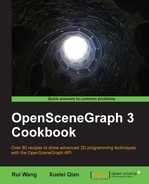Book Description
Exactly 100 recipes to show advanced 3D programming techniques with the OpenSceneGraph API.
- Introduce the latest OpenSceneGraph features to create stunning graphics, as well as integration with other famous libraries
- Produce high-quality programs with short and familiar code
- Enriched with a lot of code and the necessary screenshots
In Detail
OpenSceneGraph is an open source 3D graphics application programming interface, used by application developers in fields such as visual simulation, computer games, virtual reality, scientific visualization, and modeling. Familiar with its concepts and APIs, and need to improve your knowledge? This book is here to help. With exactly 100 recipes, it will enrich your experience and take you to the next level.
OpenSceneGraph 3 Cookbook will escort you into the world of real-time 3D development with OpenSceneGraph, the world famous 3D graphics engine. The book assumes that you are already familiar with some basic concepts, and provides 100 vivid recipes to demonstrate how to utilize the API flexibly and how to implement some practical aspects.
The book is divided into 10 chapters, each of which focuses on one topic. Readers may start from any topic they are interested in.
The book includes customizing OpenSceneGraph, designing scene graph, geometry, scene navigation, animations, effects using fixed pipeline and shaders, managing mass data, and miscellaneous discussions. Every recipe will prove to be useful in a practical way or in research.
OpenSceneGraph 3 Cookbook gives you a wide insight about 3D programming using OpenSceneGraph, with a set of meaningful and interesting examples.
Table of Contents
- Copyright
- Credits
- About the Authors
- About the Reviewers
- www.PacktPub.com
- Preface
- 1. Customizing OpenSceneGraph
- Introduction
- Checking out the latest version of OSG
- Configuring CMake options
- Building common plugins
- Compiling and packaging OSG on different platforms
- Compiling and using OSG on mobile devices
- Compiling and using dynamic and static libraries
- Generating the API documentation
- Creating your own project using CMake
- 2. Designing the Scene Graph
- Introduction
- Using smart and observer pointers
- Sharing and cloning objects
- Computing the world bounding box of any node
- Creating a running car
- Mirroring the scene graph
- Designing a breadth-first node visitor
- Implementing a background image node
- Making your node always face the screen
- Using draw callbacks to execute NVIDIA Cg functions
- Implementing a compass node
- 3. Editing Geometry Models
- Introduction
- Creating a polygon with borderlines
- Extruding a 2D shape to 3D
- Drawing a NURBS surface
- Drawing a dynamic clock on the screen
- Drawing a ribbon following a model
- Selecting and highlighting a model
- Selecting a triangle face of the model
- Selecting a point on the model
- Using vertex-displacement mapping in shaders
- Using the draw instanced extension
- 4. Manipulating the View
- Introduction
- Setting up views on multiple screens
- Using slave cameras to simulate a power-wall
- Using depth partition to display huge scenes
- Implementing the radar map
- Showing the top, front, and side views of a model
- Manipulating the top, front, and side views
- Following a moving model
- Using manipulators to follow models
- Designing a 2D camera manipulator
- Manipulating the view with joysticks
- 5. Animating Everything
- Introduction
- Opening and closing doors
- Playing a movie in the 3D world
- Designing scrolling text
- Implementing morph geometry
- Fading in and out
- Animating a flight on fire
- Dynamically lighting within shaders
- Creating a simple Galaxian game
- Building a skeleton system
- Skinning a customized mesh
- Letting the physics engine be
- 6. Designing Creative Effects
- Introduction
- Using the bump mapping technique
- Simulating the view-dependent shadow
- Implementing transparency with multiple passes
- Reading and displaying the depth buffer
- Implementing the night vision effect
- Implementing the depth-of-field effect
- Designing a skybox with the cube map
- Creating a simple water effect
- Creating a piece of cloud
- Customizing the state attribute
- 7. Visualizing the World
- Introduction
- Preparing the VirtualPlanetBuilder (VPB) tool
- Generating a small terrain database
- Generating terrain database on the earth
- Working with multiple imagery and elevation data
- Patching an existing terrain database with newer data
- Building NVTT support for device-independent generation
- Using SSH to implement cluster generation
- Loading and rendering terrain from the Internet
- 8. Managing Massive Amounts of Data
- Introduction
- Merging geometry data
- Compressing texture
- Sharing scene objects
- Configuring the database pager
- Designing a simple culling strategy
- Using occlusion query to cull objects
- Managing scene objects with an octree algorithm
- Rendering point cloud data with draw instancing
- Speeding up the scene intersections
- 9. Integrating with GUI
- Introduction
- Integrating OSG with Qt
- Starting rendering loops in separate threads
- Embedding Qt widgets into the scene
- Embedding CEGUI elements into the scene
- Using the osgWidget library
- Using OSG components in GLUT
- Running OSG examples on Android
- Embedding OSG into web browsers
- Designing the command buffer mechanism
